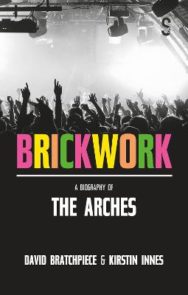‘For many, those railway arches underneath Glasgow’s Central Station will always be synonymous with the best of Scottish arts and culture and what belief, perseverance and a little bit of anarchy can accomplish.’
As part of the Year of Scotland’s Stories, we are running a series of Responses on BooksfromScotland, commissioning writers to respond to books from the publishing membership, engaging with work in different ways. For July, and our theme of ‘Beyond Words’, music writer and editor Arusa Qureshi heads to The Arches and its history in Brickwork, celebrating the vibrant world of live music.
Brickwork: A Biography of the Arches
By Kirsten Innes and David Bratchpiece
Published by Salamander Street
Buildings and physical spaces can often hold more weight in our lives than we realise. They may be structures with a purpose, bricks and mortar shelters and meeting places, but they can also be the birthplace of communities, creative havens and personal sanctuaries for those looking for a sense of belonging. Never has this been more true than over the past two years, when we were suddenly unable to set foot in these buildings that we call our second homes, be they music venues, clubs, theatres, or arts hubs. The longer stages remained empty and audiences isolated, the more it felt likely that we could lose these spaces for good. The Music Venue Trust’s Save Our Venues campaign, which was launched in an attempt to save hundreds of grassroots music venues around the UK, was a good indication of the dire situation facing not just one sector, but many others too. The thought of not being able to accidentally discover your next musical obsession in your favourite venue or to dance with your best pals in a 100-capacity sweatbox felt all too devastating.
It was during one of these periods of immense frustration and sadness that I happened to first pick up Brickwork. Kirstin Innes and David Bratchpiece’s biography of The Arches highlights exactly how much a physical space can mean to the people working and interacting with it, and why it becomes so much more than just a building. For many, those railway arches underneath Glasgow’s Central Station will always be synonymous with the best of Scottish arts and culture and what belief, perseverance and a little bit of anarchy can accomplish. By expertly piecing together varying accounts from artists, audiences and ex-staff, Innes and Bratchpiece (also two former employees) invite you to step into this slightly mad world and get immersed in the conversations and memories of those that knew and loved it.
We’re told first-hand tales of some of the venue’s famous visitors, like a young Banksy, Lily Savage and Daft Punk; memorable exhibitions including the Fotofeis porn exhibition of 1998; increasingly regular raids and police visits; general chaos like the time they had to fashion a wooden dance floor with no notice to satisfy Building Control, who refused to grant a licence for a Slam night without one; and of course, how The Arches was likely where the famed ‘here we f***ing go’ chant originated.
When the closure of The Arches was announced in 2015, I was towards the end of my undergraduate degree and I distinctly remember the uproar from all sides; the petition that was signed by what felt like everyone I knew, the famous faces that tried to urge the government to step in and the overwhelming melancholy within the arts community. I was too young to visit The Arches in its heyday but I’m still incredibly grateful that I experienced
at least a few years of gigs and club nights and could understand the magic and DIY-spirit that was encapsulated within the space. At the time, The Arches’ demise felt avoidable and it’s somewhat cathartic to be able to read narratives that echo this sentiment in Brickwork, knowing that our anger was justified. The way that Innes and Bratchpiece weave together the different conversations to emphasise the celebratory, welcoming atmosphere of The Arches is balanced well with honest thoughts on its closure and the disappointment that was certainly shared across the board.
For almost 25 years, this building housed world-class theatre, art, club nights and a very specific kind of local hedonism that inevitably brought people together. As Innes and Bratchpiece say in the book, ‘The Arches was where Glasgow came to play, and the stories about it are legendary.’ It feels special to get such a personal insight from notable figures like founder Andy Arnold, DJ and Arches patron Carl Cox and the first Arches artist-in-residence Al Seed, among others. But above all else, reading Brickwork makes you feel like you were privy to a pretty remarkable period in Scottish history, even just as a punter. On a personal level, it also makes me wish I had been able to spend just a little more time there, soaking up that brilliant atmosphere that people still talk about to this day.
In some ways, lockdown was probably the best time to read Brickwork because it reminded me of the true value of physical, democratic spaces like The Arches. They’re not just buildings, but places where strong, vibrant communities are created and built upon; where truly mind-blowing things can and do happen, and where you can so easily find your tribe. It reiterated to me what was at stake as our venues lay empty and how easy it is for resources to disappear without a trace, especially without the backing of those in positions of power. Many talk of how The Arches got away with so much in its mission to constantly push the boat out, and that may be true but in reading the various narratives in Brickwork, it seems as though that energy and sense of defiance has been kept alive by those that had any connection to the venue. Brickwork may be the story of a failed experiment but it’s also the story of a legacy that continues to inform and influence the most exciting elements of Scotland’s cultural landscape.
Brickwork: A Biography of the Arches by Kirsten Innes and David Bratchpiece is published by Salamander Street, priced £12.99.
The Year of Stories x Books from Scotland response strand was inspired by Fringe of Colour’s series, which you can read more of at fringeofcolour.co.uk.
ALSO IN THIS ISSUE

 Creative Response: Arusa Qureshi on Brickwork
Creative Response: Arusa Qureshi on Brickwork
‘For many, those railway arches underneath Glasgow’s Central Station will always be synonymous with …

 Seasonality
Seasonality
‘It is about what I see, what I hear and what I feel as I observe the ever-changing beauty that surr …













